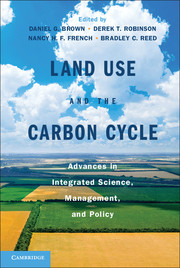Book contents
- Frontmatter
- Contents
- Chapter Authors and Affiliations
- Acknowledgments
- Acronyms
- Part I Introduction
- Part II Measurement and Modeling
- 5 Remote Sensing for Mapping and Modeling of Land-Based Carbon Flux and Storage
- 6 Atmospheric Observations and Inverse Modeling Approaches for Identifying Geographical Sources and Sinks of Carbon
- 7 Limitations, Challenges, and Solutions to Integrating Carbon Dynamics with Land-Use Models
- 8 Modeling for Integrating Science and Management
- Part III Integrated Science and Research Applications
- Part IV Land Policy, Management, and the Carbon Cycle
- Part V Synthesis and Future Directions
- Index
- Plate Section
- References
8 - Modeling for Integrating Science and Management
Published online by Cambridge University Press: 05 February 2013
- Frontmatter
- Contents
- Chapter Authors and Affiliations
- Acknowledgments
- Acronyms
- Part I Introduction
- Part II Measurement and Modeling
- 5 Remote Sensing for Mapping and Modeling of Land-Based Carbon Flux and Storage
- 6 Atmospheric Observations and Inverse Modeling Approaches for Identifying Geographical Sources and Sinks of Carbon
- 7 Limitations, Challenges, and Solutions to Integrating Carbon Dynamics with Land-Use Models
- 8 Modeling for Integrating Science and Management
- Part III Integrated Science and Research Applications
- Part IV Land Policy, Management, and the Carbon Cycle
- Part V Synthesis and Future Directions
- Index
- Plate Section
- References
Summary
Introduction
The stakeholders involved in management of land and carbon (C) are diverse. Farmers and foresters are concerned with plants and management practices that are most likely to sustain profits. The opportunity to sell C sequestration credits adds a new dimension to production strategies. Land managers may be asking questions, such as how tillage and fertilizer practices in a specific location affect C storage and crop yields. Regional planners and governing bodies may have the opportunity to influence where and how cultivation occurs and interacts with other land uses and industries. They may ask questions related to how crops can be distributed across a landscape to achieve multiple goals that reflect local priorities (water quality, scenic views, traditional lifestyles, tax revenues, etc.). At state and national levels, there are requirements to manage human activities to comply with land, water, and air-emission regulations as well as policy objectives such as job creation and energy security. Decision makers at these levels may desire guidance on how the interactions of policy options provide incentives or disincentives for certain land-use practices and resulting environmental and socioeconomic impacts. Many decision makers are most interested in how scientific information can be used to guide land-use practices in the near term, typically one to five years. However, the scientific information may derive from data measured at entirely different scales or locations and in time spans that range from decades to centuries. With rising attention to global markets and climate change, managers are concerned about how changes in their region are affected by global processes. National and regional decision makers want to know how their choices affect productivity, incomes, C and nutrient cycles, and other development goals. There needs to be a better match between the diverse needs of managers and the information provided by scientific analysis and models.
Information
- Type
- Chapter
- Information
- Land Use and the Carbon CycleAdvances in Integrated Science, Management, and Policy, pp. 209 - 238Publisher: Cambridge University PressPrint publication year: 2013
References
Accessibility standard: Unknown
Why this information is here
This section outlines the accessibility features of this content - including support for screen readers, full keyboard navigation and high-contrast display options. This may not be relevant for you.Accessibility Information
- 3
- Cited by
